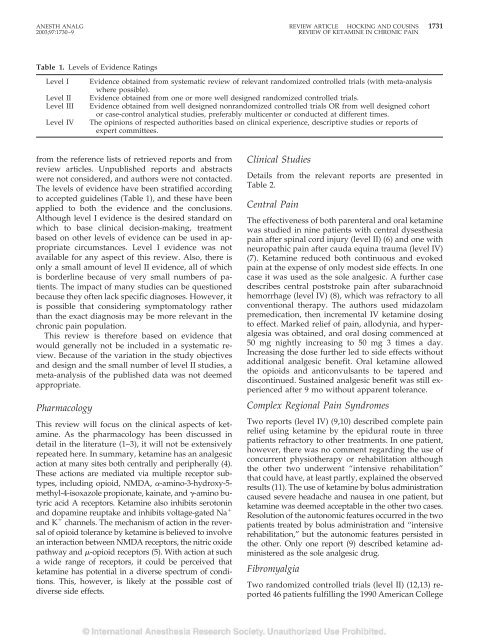Ketamine in Chronic Pain Management: An Evidence-Based Review
Ketamine in Chronic Pain Management: An Evidence-Based Review
Ketamine in Chronic Pain Management: An Evidence-Based Review
You also want an ePaper? Increase the reach of your titles
YUMPU automatically turns print PDFs into web optimized ePapers that Google loves.
ANESTH ANALG REVIEW ARTICLE HOCKING AND COUSINS 1731<br />
2003;97:1730–9 REVIEW OF KETAMINE IN CHRONIC PAIN<br />
Table 1. Levels of <strong>Evidence</strong> Rat<strong>in</strong>gs<br />
Level I<br />
Level II<br />
Level III<br />
Level IV<br />
<strong>Evidence</strong> obta<strong>in</strong>ed from systematic review of relevant randomized controlled trials (with meta-analysis<br />
where possible).<br />
<strong>Evidence</strong> obta<strong>in</strong>ed from one or more well designed randomized controlled trials.<br />
<strong>Evidence</strong> obta<strong>in</strong>ed from well designed nonrandomized controlled trials OR from well designed cohort<br />
or case-control analytical studies, preferably multicenter or conducted at different times.<br />
The op<strong>in</strong>ions of respected authorities based on cl<strong>in</strong>ical experience, descriptive studies or reports of<br />
expert committees.<br />
from the reference lists of retrieved reports and from<br />
review articles. Unpublished reports and abstracts<br />
were not considered, and authors were not contacted.<br />
The levels of evidence have been stratified accord<strong>in</strong>g<br />
to accepted guidel<strong>in</strong>es (Table 1), and these have been<br />
applied to both the evidence and the conclusions.<br />
Although level I evidence is the desired standard on<br />
which to base cl<strong>in</strong>ical decision-mak<strong>in</strong>g, treatment<br />
based on other levels of evidence can be used <strong>in</strong> appropriate<br />
circumstances. Level I evidence was not<br />
available for any aspect of this review. Also, there is<br />
only a small amount of level II evidence, all of which<br />
is borderl<strong>in</strong>e because of very small numbers of patients.<br />
The impact of many studies can be questioned<br />
because they often lack specific diagnoses. However, it<br />
is possible that consider<strong>in</strong>g symptomatology rather<br />
than the exact diagnosis may be more relevant <strong>in</strong> the<br />
chronic pa<strong>in</strong> population.<br />
This review is therefore based on evidence that<br />
would generally not be <strong>in</strong>cluded <strong>in</strong> a systematic review.<br />
Because of the variation <strong>in</strong> the study objectives<br />
and design and the small number of level II studies, a<br />
meta-analysis of the published data was not deemed<br />
appropriate.<br />
Pharmacology<br />
This review will focus on the cl<strong>in</strong>ical aspects of ketam<strong>in</strong>e.<br />
As the pharmacology has been discussed <strong>in</strong><br />
detail <strong>in</strong> the literature (1–3), it will not be extensively<br />
repeated here. In summary, ketam<strong>in</strong>e has an analgesic<br />
action at many sites both centrally and peripherally (4).<br />
These actions are mediated via multiple receptor subtypes,<br />
<strong>in</strong>clud<strong>in</strong>g opioid, NMDA, -am<strong>in</strong>o-3-hydroxy-5-<br />
methyl-4-isoxazole propionate, ka<strong>in</strong>ate, and -am<strong>in</strong>o butyric<br />
acid A receptors. <strong>Ketam<strong>in</strong>e</strong> also <strong>in</strong>hibits seroton<strong>in</strong><br />
and dopam<strong>in</strong>e reuptake and <strong>in</strong>hibits voltage-gated Na <br />
and K channels. The mechanism of action <strong>in</strong> the reversal<br />
of opioid tolerance by ketam<strong>in</strong>e is believed to <strong>in</strong>volve<br />
an <strong>in</strong>teraction between NMDA receptors, the nitric oxide<br />
pathway and -opioid receptors (5). With action at such<br />
a wide range of receptors, it could be perceived that<br />
ketam<strong>in</strong>e has potential <strong>in</strong> a diverse spectrum of conditions.<br />
This, however, is likely at the possible cost of<br />
diverse side effects.<br />
Cl<strong>in</strong>ical Studies<br />
Details from the relevant reports are presented <strong>in</strong><br />
Table 2.<br />
Central Pa<strong>in</strong><br />
The effectiveness of both parenteral and oral ketam<strong>in</strong>e<br />
was studied <strong>in</strong> n<strong>in</strong>e patients with central dysesthesia<br />
pa<strong>in</strong> after sp<strong>in</strong>al cord <strong>in</strong>jury (level II) (6) and one with<br />
neuropathic pa<strong>in</strong> after cauda equ<strong>in</strong>a trauma (level IV)<br />
(7). <strong>Ketam<strong>in</strong>e</strong> reduced both cont<strong>in</strong>uous and evoked<br />
pa<strong>in</strong> at the expense of only modest side effects. In one<br />
case it was used as the sole analgesic. A further case<br />
describes central poststroke pa<strong>in</strong> after subarachnoid<br />
hemorrhage (level IV) (8), which was refractory to all<br />
conventional therapy. The authors used midazolam<br />
premedication, then <strong>in</strong>cremental IV ketam<strong>in</strong>e dos<strong>in</strong>g<br />
to effect. Marked relief of pa<strong>in</strong>, allodynia, and hyperalgesia<br />
was obta<strong>in</strong>ed, and oral dos<strong>in</strong>g commenced at<br />
50 mg nightly <strong>in</strong>creas<strong>in</strong>g to 50 mg 3 times a day.<br />
Increas<strong>in</strong>g the dose further led to side effects without<br />
additional analgesic benefit. Oral ketam<strong>in</strong>e allowed<br />
the opioids and anticonvulsants to be tapered and<br />
discont<strong>in</strong>ued. Susta<strong>in</strong>ed analgesic benefit was still experienced<br />
after 9 mo without apparent tolerance.<br />
Complex Regional Pa<strong>in</strong> Syndromes<br />
Two reports (level IV) (9,10) described complete pa<strong>in</strong><br />
relief us<strong>in</strong>g ketam<strong>in</strong>e by the epidural route <strong>in</strong> three<br />
patients refractory to other treatments. In one patient,<br />
however, there was no comment regard<strong>in</strong>g the use of<br />
concurrent physiotherapy or rehabilitation although<br />
the other two underwent “<strong>in</strong>tensive rehabilitation”<br />
that could have, at least partly, expla<strong>in</strong>ed the observed<br />
results (11). The use of ketam<strong>in</strong>e by bolus adm<strong>in</strong>istration<br />
caused severe headache and nausea <strong>in</strong> one patient, but<br />
ketam<strong>in</strong>e was deemed acceptable <strong>in</strong> the other two cases.<br />
Resolution of the autonomic features occurred <strong>in</strong> the two<br />
patients treated by bolus adm<strong>in</strong>istration and “<strong>in</strong>tensive<br />
rehabilitation,” but the autonomic features persisted <strong>in</strong><br />
the other. Only one report (9) described ketam<strong>in</strong>e adm<strong>in</strong>istered<br />
as the sole analgesic drug.<br />
Fibromyalgia<br />
Two randomized controlled trials (level II) (12,13) reported<br />
46 patients fulfill<strong>in</strong>g the 1990 American College
















